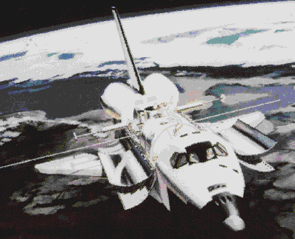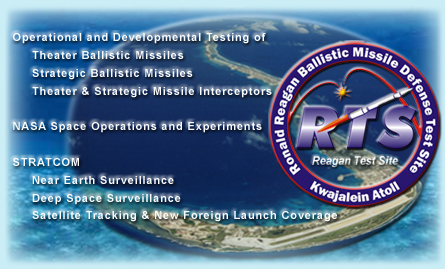|
|
|||
| Reagan Test Site / Kwajalein
Missile Range
The U.S.Army’s premier Ballistic Missile Defense Test Site at Kwajalein, supporting Deep Space Operations is an integral part of the Pacific Range. The more than 100 islands of the atoll form the world’s largest lagoon. This feature, coupled with its isolated location and specialized state-of-the-art data-gathering devices, makes the range uniquely qualified for effective live testing of missiles of all ranges. Kwajalein is operated by a government/contractor team of approximately 2,800 that includes military personnel, government civilians, technical support contractors, and scientists from MIT Lincoln Laboratory. |
|||
|
|||
| A World Class Range
The U.S. Army's Reagan Test Site (RTS) is a premiere asset within the Department of Defense Major Range and Test Facility Base. The unquestioned value of RTS to the MRTFB is based upon its strategic geographical location, unique instrumentation, and unsurpassed capability to support ballistic missile testing and space operations. With nearly 40 years of successful support, RTS provides a vital role in the research, development, test and evaluation effort of America's missile defense and space programs. RTS is an ideal site for observing new foreign launches;
maintaining the near earth satellite catalog; and tracking and surveillance
of deep space and synchronous satellites, particularly those in low inclination
orbits.
SOURCE:
http://www.smdc.army.mil/RTS.html
 NOTE: This is the same organization that did the Project Horizon back in 1958 and when I requested a document from a NASA historian my request was forwarded unbeknownst by me to five other agencies, with this being the last. I was sent an FOIA request form and currently have Vol. 1 and Vol. 4 of a four volume set. I am still working on the other two volumes For more on Project Horizon, see our link on the main menu |
|||
| This early coverage of launches from foreign launch facilities demands a continuous high state of readiness at the test site, defined by a 15-minute recall availability 24-hours-a-day, 365-days-a-year. The site is also involved in most domestic and cooperative launch programs, including the space shuttle, Atlas and Delta launches out of the Eastern and Western ranges and the European Space Agency Ariane program launched from French Guiana. - Army_Kwajalein_Atolls_Space_Surveillance.pdf | |||
| U.S. Army Kwajalein Atoll/Kwajalein Missile Range (USAKA/KMR) is a remote (located in the Republic of the Marshall Islands), secure activity of the Major Range and Test Facility Base as constituted by DoD Directive 3200.11. Its function is to support test and evaluation of major Army and DoD missile systems, Army Space surveillance and object identification, and National Aeronautics and Space Administration (NASA) scientific and space programs. Programs supported include Army missile defense, Ballistic Missile Defense Organization (BMDO) demonstration/validation tests, Air Force Intercontinental Ballistic Missile (ICBM) development and operational tests, U.S. Space Surveillance Network, and NASA Space Transportation System. - Mission Description and Budget Item Justification | |||
| Information Supplied by: Melbourne_Militia
a Member of ATS THIS
POST ID3489307
Book Titled "High Frontier"
by General Daniel O.Graham
It was written in 1983, published
by Tom Doherty Associates,Inc.
On the first page is a quote by Congressman Newt Gingrich which I shall type out below, but which may hint at what this Secret Space Station's possible usage may be. By Newt Gingrich
" . . . He who Controls Space
may well control the future of Mankind. We have a chance, through High
Frontier, using existing technology to develop a space program that is
absolutely necessary to our survival and that will give us a chance to
move past the Russians to assure our own nation and freedom a future on
this planet"
|
|||
|
SPACE COMMAND General Kevin P. Chilton Commander, Air Force Space Command "The establishment of Space Command is a crucial milestone
in
Beginning in the mid-1980s, concurrent with the development of space operations and space engineering curricula at the Naval Postgraduate School, the Navy began “coding” officers as space subspecialists. As space subspecialty codes were then assigned to particular officers’ billets on numbered Fleet staffs and at commands ashore, the service began assigning Navy members with matching codes to those positions. More recently, the Navy has begun efforts to build a cadre of “space smart” officers, enlisted personnel and civilian employees. The Naval Space Cadre is composed of active-duty and reserve Navy and Marine Corps officers and enlisted personnel, along with Navy civilian employees from a wide range of career fields who meet mandatory education, training and experience standards established for a particular certification level. The Navy Space Cadre is a distinct body of expertise horizontally and vertically integrated within Navy and Marine Corps active duty, reserves and civilian employee communities organized to operationalize space Initial identification of the cadre began in mid-2001 with the standup of the Naval Space Cadre Working Group and culminated in a naval message (NAVADMIN 201/03 DTG211435Z JUL 03) announcing the first 700 officer members of the cadre. These officers were identified by the subspecialty codes of 6206, Space Systems Operations, and 5500, Space Systems Engineering or by the additional qualification designator of VS1, VS2, VS3 or VS4. Identification of enlisted and civilian cadre members is more challenging, as these groups do not have specif?ic space identifiers like the officers do. Approximately 265 billets are currently identified as space billets. These jobs are in Navy, joint and National Security Space organizations. Space cadre members are currently assigned throughout the National Security Space arena, including the National Reconnaissance Office, National Security Space Architect, National Security Space Integration, MILSATCOM Joint Program Office, as well as in all Navy organizations that deal with space. High Frontier
|
|||
| General Kevin P. Chilton
Commander, Air Force Space Command "The establishment of Space
Command is a crucial milestone in
This year, we celebrate two significant milestones in Air Force history--the 60th anniversary of the Air Force as a separate service, and the 25th birthday of Air Force Space Command (AFSPC). The men and women, past and present, who have made this Command a relevant provider of combat effects for all mediums and levels of warfare should be proud of their accomplishments. As we engage in global combat operations, we see every day how our space and missile forces play a significant role in support of land, sea, and air combat operations. Space effects are integrated on tactical battlefields, within operational command and control centers, and for strategic homeland defense. Every day, AFSPC is delivering on its mission statement, "To deliver trained and ready Airmen with unrivaled space capabilities to defend America." This special edition of High Frontier captures the
essence of our proud heritage of delivering first-class space professionals
and superlative space power while we prepare for future challenges.
SOURCE:
Air Force Space Command
|
|||
|
|


